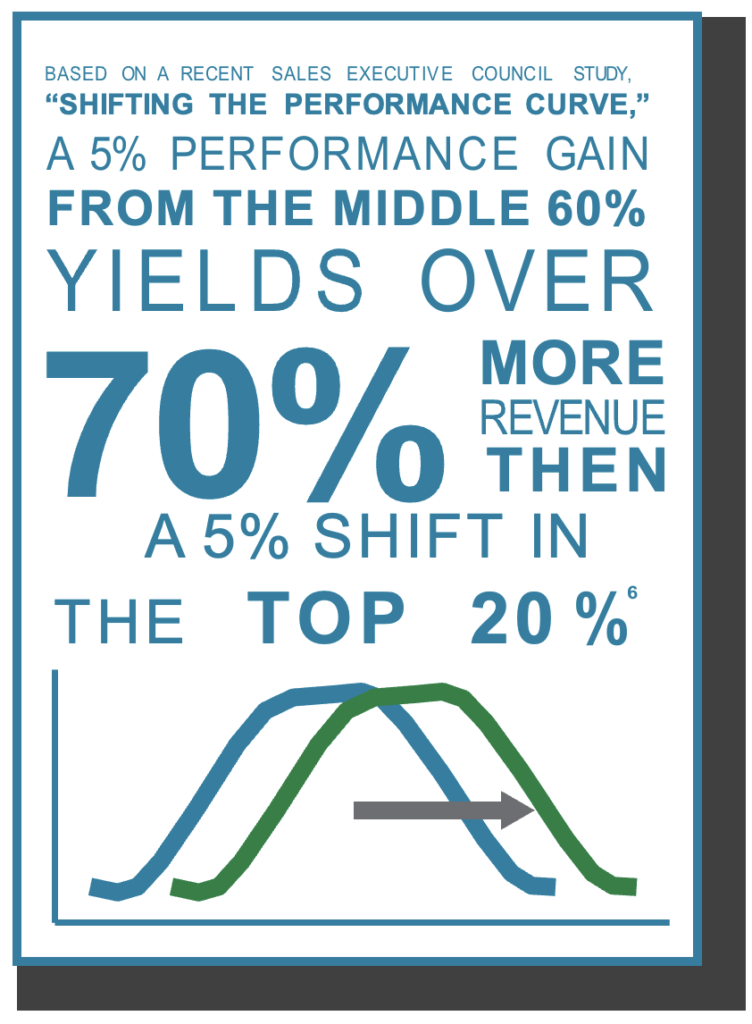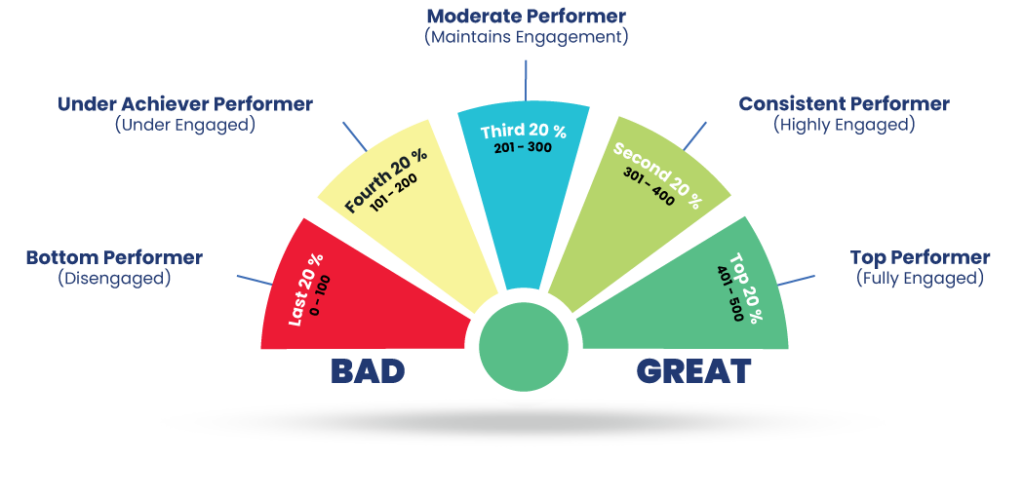Build a coaching culture. Drive results with analytics. Forecast future success.

Introduction
Sales performance is top of mind for both sales leaders and finance executives. However, achieving meaningful, sustainable sales improvement has long been an elusive target. Organizations have a tendency to rely primarily on quota attainment data supplemented by anecdotal reports of performance to evaluate sales effectiveness and improvement. This is understandable, given that sales leaders often lack access to reliable data that would enable them to assess sales performance authentically and accurately. An information and data gap exists and companies often sacrifice critical business opportunities, customers, employees and market share as a result of their inability to accurately assess and improve sales performance. The time to close this gap is now.
Analytical and sales performance management tools are needed now more than ever. These tools must possess the capability to pinpoint precise performance issues, highlight ways for sales managers to coach to specific problem areas, and support sales reps to take ownership of their behaviors. Without these capabilities in place, sales reps will continually revert back to the behaviors that are comfortable to them and sustained improvement will never be achieved.
How should companies rethink sales performance management and what should they do? The key rests in what we believe is a unique combination of 1) focusing on managers to build a coaching culture and 2) driving sustained performance results with analytics that
can both identify the current state and predict future success with accuracy. This paper explores how organizations can begin to develop this winning combination with the help of RevenueForce, a platform that drives sustained sales performance improvement.
KEY QUESTIONS
ON THE MINDS OF
SALES LEADERS

The modern sales landscape is filled with challenges for leaders to navigate
According to CSO (Chief Sales Officer) Insights, 37.8 percent of sales reps missed their quotas in 20131. This statistic is startling, especially given that organizations spend billions annually on performance assessments, training, sales methodologies, and new technology platforms. Despite this investment, sales leaders often struggle with understanding which of these investments, if any, are driving a genuine improvement in sales performance. Specifically, we find that organizations seem to grapple most with the following:
- Significant investments in sales training and development lack measurement of value – Companies spend billions of dollars every year on sales training, but they find it difficult to measure value. One study reported that 90 percent of all corporate sales training programs yielded only a 90 to 120-day increase in sales productivity before returning to pre-training levels2. Similar studies showed as little as a six-week lift. Overall, 85 percent of overall sales training fails to deliver results.
- Application of training misses the mark when coaching is limited or absent – Typically sales managers spend less than 20 percent of their time on coaching. Pressed for time and immersed in sales reporting and planning activities, many managers assert they cannot prioritize their duties so that they can devote an adequate portion of time to coaching. This is critical, given that a sales rep’s percentage-to-quota can be as much as 19 percent greater when teams are supported by highly effective coaches1. Furthermore, in “The Dirty Secret of Effective Sales Coaching,” the Harvard Business Review finds that sales managers often skew their coaching efforts dramatically toward the “tails” – the very best and the very worst reps on the team3. However, greater improvements can often be realized when focusing on moderate performers.
- Forecasts suffer without true predictive indicators – While analytical tools have become more sophisticated in recent years, many lack true predictive indicators, so forecasts remain inaccurate. Given the volume of data that organizations and customers are generating, sales leaders are now better positioned than ever to predict future success. However, many of them don’t have the right tools to do so.
- Mistaken belief that the latest and greatest sales methodology holds the key to success – Sales effectiveness has little to do with the adoption of the latest and greatest sales methodology. If sales success was about the methodology, an organization could train its sales teams in the same ways and every seller would become a top performer. At its core, sales effectiveness has to do with a seller’s ability to execute – to go from the classroom to the field and then to performing effectively – and then continuously overcome barriers to growth, take ownership of actions, and embrace new paradigms.
- Potential of middle performers is underestimated – Most sales reps fall somewhere in the middle on the performance bell curve. The common misconception is that B-Players are simply average performers who lack the drive of their higher performing peers4. The reality, however, is that many of these individuals are competent producers capable of greater performance. They key is to figure out which of the B-Players possess the characteristics to make the leap to become high performers.

Despite best intentions, most organizations fall short. It’s time for a change.
In spite of good intentions and deep spend on training, organizations’ investments are not helping to change behavior in the field or having a noteworthy impact on sales performance improvement. Even if more sales managers could prioritize duties and allow more time for coaching, they are hard-pressed to deliver coaching in ways that are meaningful and engaging to their team members, much less drive true performance improvements.
Sales managers need to become equipped to not only identify and understand improvement opportunities for each individual sales rep, but support and encourage sales reps to own their professional development through effective one- to-one coaching. Ultimately, managers need to be given the tools to:
- Diagnose specific behavioral changes needed to help sales reps improve
- Coach effectively to specific performance issues
- Make coaching a collaborative experience between themselves and their team members
RevenueForce is a game-changing tool that can help managers do just that. It predicts future success of individual sales reps, diagnoses specific performance issues to identify coaching opportunities, and creates a platform for organizations to drive sustained sales performance improvement.

A PREDICTIVE SCORE FOR SALES REPS
The RevenueForce Score uses multiple inputs to quantify the probability of an individual sales rep to meet his or her organization’s objectives. The score predicts performance based on leading indicators (activities that drive opportunities), lagging indicators (outcomes or results), sales skills and personality attributes. Additionally, it provides sales managers with a way to diagnose the reasons why a rep is underperforming and coach to the areas that will provide the greatest level of improvement for that specific individual.

Getting started by building a coaching culture rooted in analytics:
RevenueForce enables sales organizations to create a sustainable coaching culture to drive short and long-term sales performance gains. To get started, follow the four-step approach outlined below:
1. Assess Your Talent
Sales reps should be assessed against both tangible sales skills as well as personality attributes. The combination of these data points when combined with quota attainment information allows you to identify which sales reps are most likely to improve.
RevenueForce has created five categories to help sales leaders assess and score talent in their sales organizations. The five categories that organize sales reps and their performance include:
- Top performer (demonstrates peak performance, is fully engaged) – These reps tend to improve with classroom training alone because they have a desire to do so. They are usually engaged fully and will devote an enormous amount of discretionary effort to activities that contribute to the company’s success.
- Consistent performer (highly engaged) – Consistent performers are highly engaged but do not possess a desire to be the best. They want to be viewed by their peers as contributors. Consistent performers will devote a considerable amount of extra time and effort when it is needed, but they set limits that are well within their comfort zones.
- Moderate performer (maintainer of status quo) – These reps tend not to improve with classroom training alone. They are usually under engaged, and will put in enough time and effort to do acceptable work and meet basic performance expectations, but not much more. They are the maintainers of both status quo and of comfort level.
- Under achiever performer (under engaged) – Under achievers fail to meet minimum job requirements and
the quality of their work is unacceptable. They are under-engaged to disengaged.
- Bottom performer (disengaged) – They under achieve for a variety of reasons. They are employees who are checked out and no one has determined why they are disengaged. Many times, these people quit their jobs – and don’t even tell anyone they have given up or checked out.
Benchmarking Study Affirms Lack Of Self-Awareness As Primary Roadblock To Performance Improvement
A sample of sales reps employed full-time with five well-known companies in a variety of industries participated in a study
conducted by RevenueForce, in cooperation with the American Association of Inside Sales Professionals.
The study evaluated key personality attributes and sales competencies as an indicator of future
performance. Results from the study showed that the lowest performing sales reps were oblivious when
it came to self-assessment and had a tendency to evaluate themselves as top performers7.
2. Define Metrics & Establish A Benchmark
RevenueForce collects four types of data that help to establish sales performance benchmarks and provide a foundation for scoring and predicting performance. The RevenueForce score is tailored to your organization and industry and generated by a proprietary algorithm based on:
- Leading indicators – Activity-based metrics that predict the sales rep’s capability to achieve the end goal. They can include such measures as number of calls/visits to prospects required per week to convert a prospect to
a customer or the number of proposals to be issued per quarter. This data helps to answer how reps are performing in terms of their level of sales activity.
- Lagging indicators – These indicators are outcomes or results. Most organizations track this data according to each rep’s sales volume and / or quota attainment.
- Skills and competency assessment – The skills and competency assessment focuses on the skills needed to be effective within a sales organization. It also creates awareness for sales reps by providing a view of how they view themselves versus their manager. This data point is particularly important because many low and moderate performers lack accurate self-perception and often benefit from a greater sense of self-awareness.
- Attributes and personality self-assessment – The attributes assessment focuses on four key personality attributes that are predictive of sales success: Integrity, Accountability, Attitude, and Motivation. It helps to determine the degree to which individuals are engaged and calls out some of the strategies they use to improve outcomes.

The RevenueForce Score is gaining recognition in the marketplace as “the new, must-have FICO score for sales reps,” according to Gary Milwit, senior vice president, Stone Street Capital, LLC.
The American Association of Inside Sales Professionals recognized Milwit as executive of the year in 2013.
3. Generate RevenueForce Scores
Once data has been collected and assessments have been completed, RevenueForce scores can be generated for your sales organization. The score allows organizations to:
- Help sales managers diagnose non-performance for their team members
- Identify corrective action needed to improve results within individual sales reps
- Rate individual sales reps’ probability to meet results
- Track performance over time
- Provide a starting point measurement or baseline requirement for new hires
4. Create a Coaching Culture
With the right data in hand, organizations have the foundation to create an environment for self-awareness and smarter coaching. However, it is critical to recognize that coaching is a competency that must be embedded into an organization’s culture.
There is no “one-size-fits-all” approach to coaching. Instead, organizations must consider their unique needs and ensure those intricacies are addressed in their assessment and coaching efforts. In addition, bringing sales managers on board early in a sales effectiveness program is critical to achieving buy-in early and creating a coaching culture.
RevenueForce provides the tools and roadmap to drive the cultural change organizations need in order to foster sales rep self-awareness and assist sales managers to:
- Diagnose those specific behavioral changes needed to help sales reps improve
- Coach effectively to specific performance issues
- Make coaching a collaborative experience between themselves and their team members

A Real-Life Coaching Culture Change
For one sales representative with a large U.S.-based financial institution, the RevenueForce assessment data was revealing. At the time of starting the process, the rep was closing four deals per month on average – tracked over a period of 12 months. Results showed lower assessment results than his peer group for attitude and motivation. Additionally, his past performance outcomes and activity levels scored him as average against his peers. Using all of this data in aggregate, the rep and his manager diagnosed his primary issue as motivation.
As an immediate next step, he worked with his sales manager to create a professional development plan that focused on motivation. His desired outcome: ”Improve the characteristics that define motivation for me – discipline, determination, drive, courage, investment, and purpose.” They also mutually identified actions he could take against this chief objective and incorporated accountability factors including:
- Remind myself daily of my overall purpose and what I want out of life and why;
- Share my goals with people I don’t want to disappoint;
- Allow my sales manager/coach to check in with me proactively and ask how I’m doing with my goals;
- Identify those things I do each week that are outside of my comfort zone and evaluate how these helped me to change and improve sales outcomes.
With the development plan in hand, the sales rep set a performance goal to close 10 deals a month on average instead of four (this goal was higher than the typical recommended incremental improvement). His original results – four deals closed per month – increased by 50 percent in just two months. RevenueForce tracked his performance over the next six months and he sustained the increase. The sales rep and his sales manager/coach attributed the performance improvement to: 1) the RevenueForce assessments which identified barriers to improvement and enabled self-diagnosis, 2) ongoing benchmarking of his performance over time and 3) execution of a professional development plan featuring goals the sales rep set and owned in partnership with his manager.

Build a coaching culture and win the sales performance game.
Most sales reps want to do a great job. Competitive by nature, they are typically receptive to tools that will allow them to improve. But many sales reps, managers and leaders just don’t know where to begin when it comes to generating sustainable improvements.
The sooner organizations change how they are investing in their sales teams and provide a platform for sales managers to better understand their sales reps and facilitate smarter coaching, the sooner they can win the sales performance game. It’s time for a change.
RevenueForce provides the platform to drive sustained change, create a coaching culture, and increase revenue.
Are you ready to win the sales performance game?
















